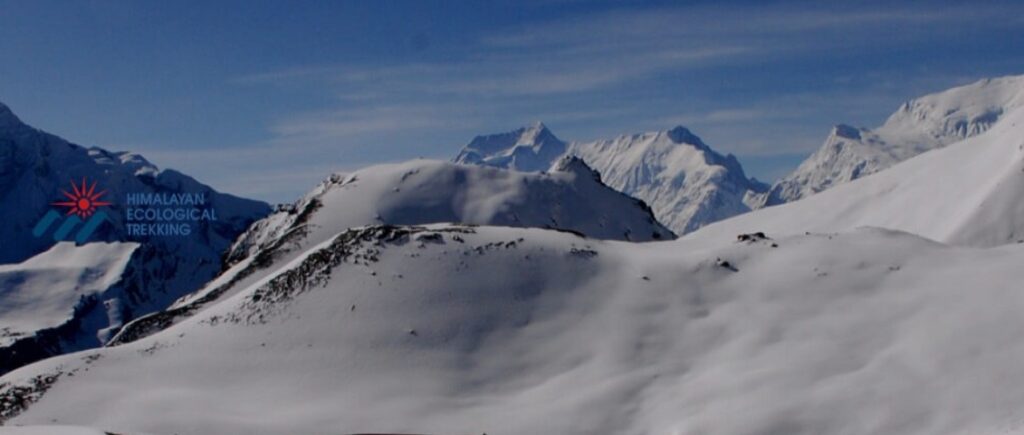The Manaslu Circuit Trekking and Tsum Valley Trekking routes offer something rare in Nepal today. They give you peace. While Everest Base Camp trails overflow with trekkers, these paths remain quiet. The Manaslu region sits in the shadow of the world’s eighth-highest mountain. It measures 8,163 meters. The Tsum Valley hides even deeper, a sacred valley that only opened to tourists in 2008. Both treks take you through authentic Tibetan Buddhist culture, untouched villages, and stunning mountain views that rival any trail in Nepal.
Why These Treks Stand Out from Popular Routes
Most people head to Annapurna or Everest. That’s changing now. The Manaslu Circuit and Tsum Valley attract trekkers who want real adventure without the crowds. You’ll walk through rhododendron forests that bloom bright red in spring. You’ll cross suspension bridges that sway over turquoise rivers. And you’ll meet locals who still live the way their ancestors did centuries ago.
The Manaslu Circuit covers about 177 kilometers. It takes 14 to 18 days depending on your pace. The highest point is Larkya La Pass at 5,160 meters. The views from this pass stretch across multiple peaks. You’ll see Himlung Himal, Cheo Himal, and Kang Guru rising against clear blue skies.
Tsum Valley branches off from the main Manaslu route. It adds another 7 to 10 days to your journey. The valley sits between the Ganesh Himal and Sringi Himal ranges. Prayer flags flutter everywhere. Mani walls line the trails. These stone walls have Buddhist mantras carved into them. Some stretch for hundreds of meters.
What the Manaslu Circuit Trekking Experience Feels Like
Starting from Soti Khola, the trail follows the Budhi Gandaki River. The first few days take you through subtropical forests. You’ll sweat in the humidity. Villages like Machha Khola and Jagat appear along the riverbank. The houses have stone walls and wooden roofs. People grow corn and millet on terraced fields.
As you climb higher, the landscape shifts. Pine forests replace banana trees. The air gets thinner. Deng, Namrung, and Lho villages introduce you to Tibetan culture. The people here speak a dialect close to Tibetan. They wear traditional clothes. Women braid their hair and wear turquoise jewelry. Men wear wool robes and felt boots.
Samagaon sits at 3,530 meters. This village serves as a rest stop. You’ll spend two nights here to adjust to the altitude. The Pungyen Gompa monastery sits above the village. Monks in red robes chant prayers. You can visit Birendra Lake for a day hike. The lake reflects the peaks around it like a mirror.
The push to Larkya La Pass starts from Samdo. You’ll wake up at 3 AM. The trail climbs steeply in darkness. Your headlamp lights the way. Ice crunches under your boots. The pass rewards you with 360-degree views. Manaslu dominates the western horizon. The descent into Bimthang feels endless. Your knees will ache. But the hot dal bhat waiting in the teahouse makes it worth it.
Exploring the Sacred Tsum Valley Trek
Tsum Valley feels like stepping into a different time. The valley remained isolated until recently. The government restricted access to preserve its culture. Today, you need a special permit to enter. This keeps tourist numbers low.
The trek diverges from the main Manaslu route at Lokpa. You’ll follow the Siyar Khola river upstream. The trail passes through Chumling, the valley’s gateway village. Prayer wheels line the path. You spin them clockwise as you walk. Each rotation sends prayers to the heavens, locals believe.
Chhokang Paro sits at 3,010 meters. The village has a nunnery where young girls study Buddhist texts. They welcome visitors with butter tea. The tea tastes salty and rich. You might not like it at first, but it warms you up fast.
Mu Gompa marks the valley’s far end. It sits at 3,700 meters near the Tibetan border. The monastery dates back hundreds of years. Murals cover the walls. They show Buddhist deities in vivid colors. The head lama might invite you for tea and share stories about the valley’s history.
Rachen Gompa houses a community of nuns. They live simply. They grow their own vegetables and make their own clothes. Their devotion to meditation and prayer creates a peaceful atmosphere. Spending time here feels calming. The stress of daily life disappears.
Best Time to Trek These Routes
Spring and autumn work best. March to May brings clear skies and warm days. The rhododendrons bloom. The forests turn red and pink. You’ll see lammergeiers and golden eagles circling overhead.
September to November offers the clearest mountain views. The monsoon has washed the air clean. Temperatures drop at night. You’ll need a good sleeping bag. But the starry skies make up for the cold.
Winter trekking is possible but challenging. Snow blocks the higher passes. Teahouses close in some villages. Summer brings monsoon rains. Leeches appear on the lower trails. The clouds hide the mountains.
Challenges You Should Know About
These treks aren’t easy. The altitude affects everyone differently. Headaches, nausea, and dizziness are common above 3,000 meters. Walking slowly helps. Drinking lots of water helps more. Some people need to descend if symptoms get severe.
The trails are rough in places. Landslides wash away sections during monsoon. Rockfalls happen. You’ll walk on narrow paths carved into cliff faces. A wrong step could be dangerous. Good trekking boots with ankle support are essential.
Teahouses provide basic accommodation. Expect thin mattresses and shared bathrooms. Hot showers cost extra. The electricity comes from solar panels or small generators. It’s unreliable. Charge your devices when you can.
The food gets repetitive. Dal bhat appears at every meal. It’s rice with lentil soup and vegetables. It fills you up and gives you energy. But after two weeks, you’ll dream about pizza.
Why Choose Himalayan Ecological Trekking P. Ltd
Planning these treks requires local knowledge. Himalayan Ecological Trekking P. Ltd specializes in responsible tourism in the Manaslu region. The company was founded by local guides who grew up in these mountains. They know every village, every monastery, and every shortcut. Their commitment to eco-friendly practices and community support sets them apart from other operators.
The guides speak excellent English. They explain the culture and history as you walk. They watch for altitude sickness symptoms. They adjust the itinerary if needed. The porters carry your heavy gear. You only need a daypack for water and snacks.
Himalayan Ecological Trekking P. Ltd handles all permits. The Manaslu Circuit requires a special restricted area permit. It costs more than standard trekking permits. The company also arranges the Tsum Valley permit. They book teahouses in advance. During peak season, rooms fill up fast.
Their small group sizes keep the impact low. You won’t be part of a 20-person convoy. Instead, you’ll trek with 4 to 8 people. This creates a better experience for you and for the villages you visit.
What to Pack and Prepare
Layers work better than heavy jackets. The temperature changes throughout the day. Mornings start cold. By noon, you’re sweating. Evenings get frigid again. Pack thermal underwear, fleece layers, and a waterproof shell.
A good sleeping bag rated to minus 10 degrees Celsius is necessary. Some teahouses provide blankets, but they’re often thin. Trekking poles save your knees on long descents. A headlamp is essential for early morning starts.
Bring water purification tablets. The teahouses serve boiled water, but it’s expensive. Filling up from streams and treating the water saves money. Pack high-energy snacks like nuts and chocolate bars. They help when you’re exhausted.
Break in your boots before the trek. New boots cause blisters. Blisters ruin treks. Wear them around your neighborhood for a few weeks first.
The Cultural Richness Along the Way
Both treks immerse you in Tibetan Buddhist culture. The monasteries aren’t tourist attractions. They’re living centers of worship. Monks and nuns dedicate their lives to spiritual practice. Watching them perform rituals gives you a glimpse into their devotion.
The locals practice polyandry in some villages. One woman might marry multiple brothers. This tradition keeps land within families. It’s rare now but still exists in remote areas.
Festivals happen throughout the year. If you time your trek right, you might witness one. The dances involve elaborate costumes and masks. The music comes from long horns and drums. The celebrations last for days.
The hospitality surprises everyone. Villagers invite trekkers into their homes for tea. They share stories despite the language barrier. Children wave and shout “Namaste” as you pass. Their smiles are genuine.
Final Thoughts on These Himalayan Adventures
The Manaslu Circuit Trekking and Tsum Valley Trekking offer what many trekkers seek but rarely find anymore. They provide solitude, authentic culture, and spectacular scenery. You won’t fight crowds for photos. You won’t feel like you’re on a tourist conveyor belt.
These treks challenge you physically and reward you spiritually. The mountains humble you with their scale. The culture enriches you with its depth. And the experience stays with you long after you return home.
Working with Himalayan Ecological Trekking P. Ltd ensures your journey supports local communities and protects the environment. Their expertise and ethical approach make the adventure safer and more meaningful. You can find more details about their treks at https://www.himalayanecologicaltrek.com/.
Go prepared. Go with respect. And go ready for an adventure that few people get to experience. The Manaslu region and Tsum Valley are waiting.




More Stories
What to Expect When You Book a Limo Service in Boulder, CO: A Simple Guide
What Makes Private Car Services and Wedding Transportation Essential in Charleston County?
The Best Wedding Party Transportation in Charleston County: A Complete Guide